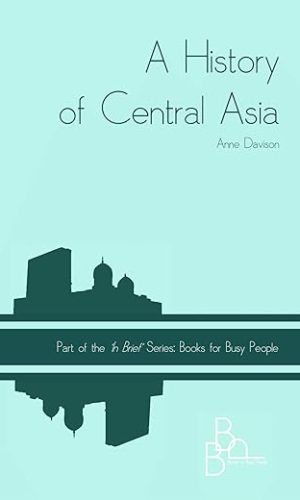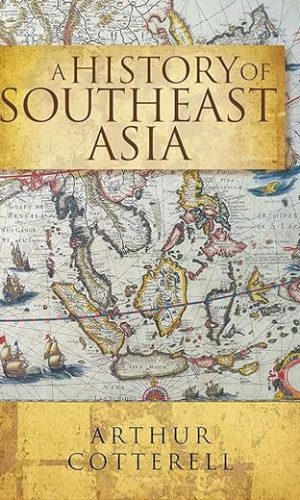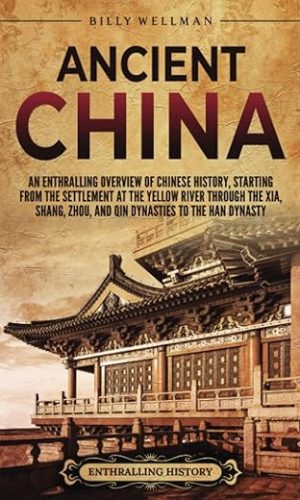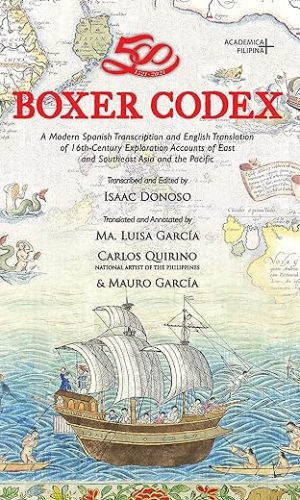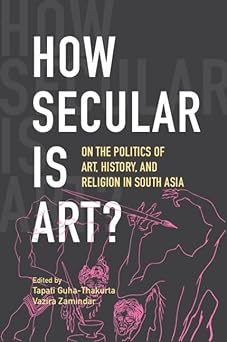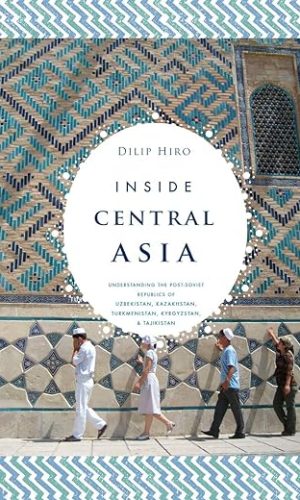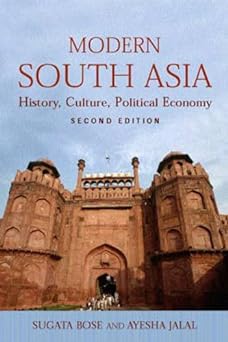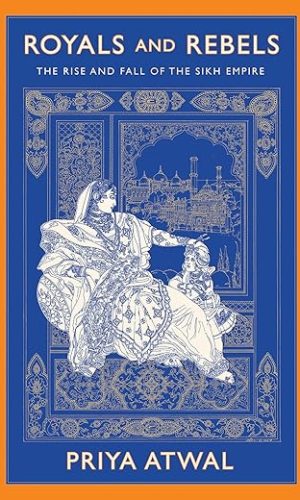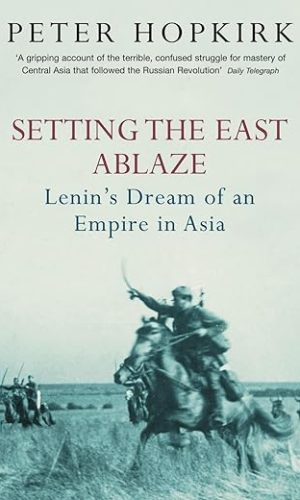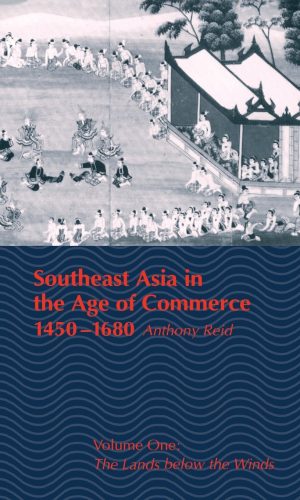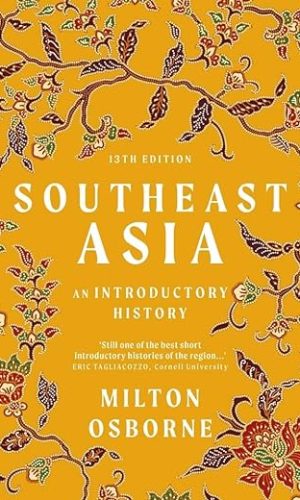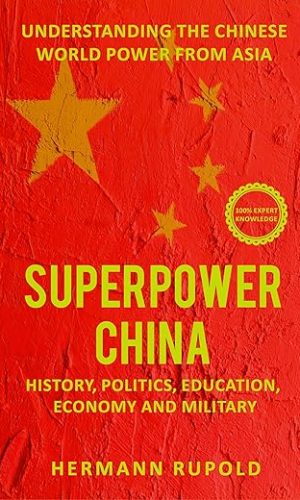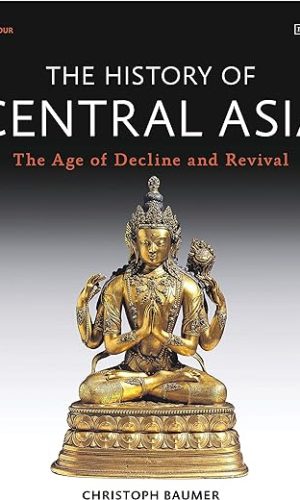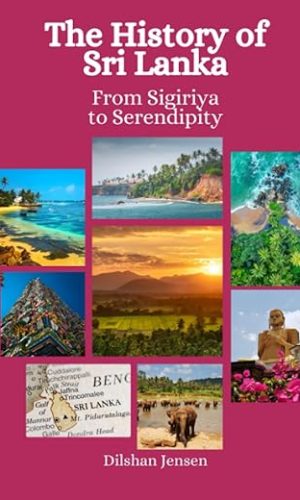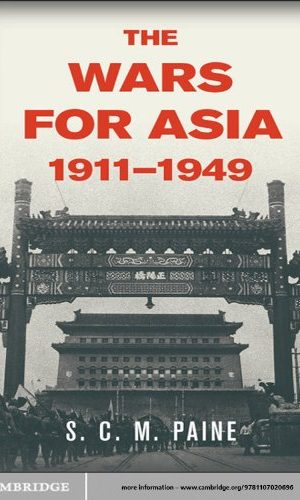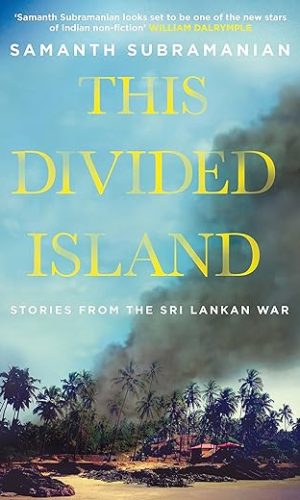Asia
-
A History of Central Asia (‘In Brief’ Books for Busy People)
For most of its history, Central Asia has been ruled by powerful dynasties, fallen under the vassalage of neighbouring empires or been invaded by foreign powers. Only the more remote, inaccessible tribal areas have maintained a degree of independence. However, since the fall of the Soviet Union in 1991, five distinct independent nation states have emerged that are now generally referred to as ‘Central Asia’, namely Uzbekistan, Tajikistan, Turkmenistan, Kazakhstan and Kyrgyzstan.
Regardless of who has been in power over the centuries, the one constant has been the significance of the land bridge that straddles the region connecting Europe and Asia, otherwise known as the Silk Road, or Roads. In ancient times, silks and spices travelled westwards, while furs, wools and precious metals took an eastward route. Consequently, those who controlled the trade-route accrued immense wealth and built great cities such as ancient Samarkand, Bukhara and Khiva.
The ancient Silk Road is now being revitalised. But rather than silks and spices, today the commodities being transported include natural gas, oil, minerals and communication systems.
This book tells the story of conquest and invasion, of empire building and colonialism. The earlier chapters include the great Persian/Iranian Empires, such as the Achaemenids, the Sassanids and the Safavids, as well as the exploits of Alexander the Great. Further chapters cover the Turkic migrations, arrival of Islam and the invasion of the Mongols. The final chapters tell of the conflict between the imperial powers of Russia and Britain, which was an event known as the Great Game. The 20th Century period of Soviet rule in Central Asia marks the final chapter and the book concludes with an Epilogue that brings the reader up to current events.
As with other books in the ‘In Brief’ series, this book is aimed at the general reader who wants to understand a particular historical topic but does not have the time or inclination to read a heavy academic tome. With this mind, footnotes have been omitted.While there will inevitably be gaps in a book of this size, the intention is to cover the most significant events that moulded Central Asia’s history. Should the reader be inspired to further reading on the subject, a small selection of the main works that have been consulted is provided at the end.
Read more
£5.10 -
A History Of South East Asia,
A History of Southeast Asia narrates the history of the region from earliest recorded times until today, covering present-day Myanmar, Thailand, Cambodia, Laos, Vietnam, Malaysia, Singapore, Brunei, the Philippines, Indonesia and East Timor. Concisely written and filled with historical anecdotes of key individuals and events, this authoritative volume is presented in three parts, covering both mainland and maritime Southeast Asia: *Part 1 – Early Southeast Asia (the earliest civilizations)*Part 2 – Late Southeast Asia (including the colonial period)*Part 3 – Modern Southeast Asia (the present-day era, following the Pacific dimension of the Second World) Superbly supported by over 200 illustrations, photographs and maps, this volume provides real insight into one of the world’s most distinctive but complicated regions, at a time when Asian countries are beginning to set the pace in the global economy.Read more
£16.20£19.00A History Of South East Asia,
£16.20£19.00 -
A Short History of South-East Asia
Explore the fascinating history of south-east AsiaA Short History of South-East Asia, Sixth Edition is the latest in a series of updated texts spotlighting this fascinating region. With revised chapters for all of the countries in this geographic area, this interesting text paints a remarkable overview of the characters and events that have shaped this part of the world. Founded upon a deeply perceptive observation of the late founding Prime Minister of Singapore Lee Kuan Yew, this book brings shape to the idea that ‘to understand the present and to anticipate the future, one must know enough of the past, enough to have a sense of the history of a people.’ With an approachable writing style and comprehensive content, this unique text was written for business readers interested in improving their understanding of this important region.
With globalization continuing to gain momentum, south-east Asia is emerging as an important business sector for many industries. Not only does this open up professional opportunities, it exposes individuals in other parts of the world to the unique histories and cultures of the area. If you are interested in learning more about the region, this abbreviated text is a wonderful resource.
- Explore historic and political developments that have taken place throughout south-east Asia
- Quickly navigate text organized by country, allowing you to dive into the events that have shaped Brunei, Cambodia, East Timor, Indonesia, Lao PDR, Malaysia, Myanmar, the Philippines, Singapore, Thailand, and Vietnam
- Gain an important global perspective, which can prove valuable on personal and professional levels
- Leverage your new understanding of the region’s past to better understand its present and anticipate its future
A Short History of South-East Asia, Sixth Edition is an abbreviated history of south-east Asia written with business readers in mind.
Read more
£17.10 -
Ancient China: An Enthralling Overview of Chinese History, Starting from the Settlement at the Yellow River through the Xia, Shang, Zhou, and Qin Dynasties to the Han Dynasty…
It has become a common theme in today’s world to talk about the incredible technological and economic development of modern China. However, there are very strong historical roots to the exponential growth of modern China going back thousands and thousands of years.Today, people stand in awe of China’s achievements, such as lifting hundreds of millions of people from poverty or becoming a global power. But have you ever wondered how the ancient people from the Far East developed so much while being virtually independent of other civilizations?
Not everything in China’s history is tied to growth, improvement, and development. There were many periods riddled with internal strife, which plagued China and its numerous dynasties. However, the Chinese empires were somewhat shielded from external dangers, partially thanks to the ingeniousness of the Chinese and the famous Great Wall of China and partially thanks to the country’s geographic position.
In this book, we look into how and why the historical pendulum of China sometimes turned one way and then the other.
Discover the following about ancient China:
- The deep, virtually unfathomable paleolithic roots of Chinese civilization;
- Neolithic China and the formation of the Yellow River and Yangtze settlements;
- The Age of Metal in China, a glorious but increasingly violent period that resulted in the emergence of the first hegemons in China;
- The mythical Xia dynasty and its fantastic Yu the Great, credited with taming the Yellow River;
- The birth of China’s fascinating writing system during the Shang dynasty;
- The rise of the Zhou, who finally overthrew the Shang, thanks to their military prowess and ability to keep numerous Chinese states tied in a loose feudal system;
- Confucius, the Chinese Socrates, who promoted peace, harmony, and wisdom;
- The absolute dissolution of the Zhou state during the Warring States Period;
- The formation of a ruthless yet efficient Qin Empire under the watchful eye of Qin Shi Huangdi;
- The rebellion against the Qin and the final victory of Liu Bang and the Han dynasty;
- And so much more!
Scroll up and click the “add to cart” button to begin learning about Ancient China today!
Read more
£10.50 -
Asia: A Concise History
From one of the world’s leading historians?a comprehensive narrative of the 3,000 years that have formed Asia’s people, culture, and global destinyTracing its origins in Mesopotamia to its modern role on the global geopolitical stage, historian Arthur Cotterell offers a compelling, lively, and readable account of one of the most culturally diverse, and often misunderstood, parts of the world. Beginning with the emergence of the world’s earliest civilization in 3000 BC, Asia: A Concise History provides a fascinating look at the global convulsions?like the rise and fall of Assyria and Persia, the medieval states that flourished after the advent of Islam, and the modern transformations triggered by the lightning conquests of imperial Japan?that have shaped the continent.
- Covers the great events and figures of Asian history, along with a look at the monumental remains that bear witness to those times: the ziggurats of Iraq, the Taj Mahal, the Great Wall of China, the temple of Angkor Wat
- Includes fascinating slices of history, including funeral arrangements for Qin Shi Huangdi in 210 BC; an extract from Lord Macartney’s journal of his 1793 diplomatic mission to the Qing emperor Qian Long; and Toyotomi Hideyoshi’s edict of 1587 banning firearms in Japan
- Features boxed inserts of special interest?like a Babylonian recipe for lamb stew circa 1500 BC
- Contains over 100 illustrations, maps, and photos
- Other books by Cotterell: The Minoan World, The First Emperor of China, The Encyclopedia of Mythology, and Chariot
Destined to become a reference staple for history buffs and students of Asian history, Asia: A Concise History offers readers a breathtaking narrative and wealth of detail that make the formative periods, key events, and personalities from this once remote part of the world come alive.
Read more
£18.00Asia: A Concise History
£18.00 -
Boxer Codex (Academica Filipina+)
In 1947, colonial Iberian maritime scholar Professor Charles R. Boxer acquired a late sixteenth-century manuscript written by an anonymous scribe who had compiled several eyewitness accounts of both Spanish and Portuguese expeditions to Asia and the Pacific. Through detailed descriptions and lavish illustrations, this manuscript depicted the customs, costumes, and ways of life of the various peoples of East and Southeast Asia, particularly the Philippine Islands. In the decades since the book came to light, an international constellation of scholars the world over has expanded our understanding of this valuable document and given us the clearest depiction of the lives of newly colonized Filipinos and the politics of early modern Asia. As such, the Boxer Codex is indispensable in understanding both Iberian and Asian encounters at a pivotal time in world history.
Now this invaluable work is made accessible to a new generation of Filipinos and scholars with this bilingual edition, written in modern Spanish and English. It also marks the beginning of the commemoration of 500 years of Philippine-Spanish encounters from 1521 to 2021. An extensive introduction situates this work in a global context and presents the intertwined histories of academician Charles Boxer and Philippine National Artist Carlos Quirino, whose friendship ignited global interest and passionate study of the codex.
Read more
£10.30 -
How Secular Is Art?: On the Politics of Art, History and Religion in South Asia
As an invitation to interrogate the secular modality of art, the book unsettles both the categories of ‘art’ and ‘secular’ in their theoretical and historical implications. It questions the temporal, spatial and cultural binaries between the ‘sacred’ and the ‘secular’ that have shaped art historical scholarship as well as artistic practice. All the essays here are anchored in a conception of a region, whether we call it South Asia or the Indian subcontinent – one, fissured by histories of partition, state formations and religious nationalisms, but still offering a collective site from which to speak to the disciplines of art and the knowledge worlds in which they are embedded. The book asks: How do we complicate the religious designations of pre-modern art and architecture and the new forms of their resurgence in contemporary iconographies and monuments? How do we re-conceptualize the public and the political, as fiery contestations and new curatorial practices reconfigure the meaning of art in the proliferating spaces of museums, galleries, biennales and festivals? How do we understand South Asian art’s deep entanglements with the politics of the present?Read more
£28.50 -
Inside Central Asia: A Political and Cultural History of Uzbekistan, Turkmenistan, Kazakhstan, Kergtzstan, Tajikstan, Turkey and Iran
The former Soviet republics of Central Asia comprise a sprawling, politically pivotal, densely populated, and richly cultured area of the world that is nonetheless poorly represented in libraries and mainstream media. Since their political incorporation in Stalin’s Soviet era, these countries have gone through a flash of political and economical evolution. But despite these rapid changes, the growth of oil wealth and U.S. jockeying, and the opening of the region to tourists and businessmen, the spirit of Central Asia has remained untouched at its core. In this comprehensive new treatment, renowned political writer and historian Dilip Hiro offers us a narrative that places the modern politics, peoples, and cultural background of this region firmly into the context of current international focus. Given the strategic location of Central Asia, its predominantly Muslim population, and its hydrocarbon and other valuable resources, it comes as no surprise that the five Central Asian republics are emerging in the twenty-first century as one of the most potentially influential-and coveted-patches of the globe.Read more
£19.00 -
Modern South Asia: History, Culture, Political Economy
Jointly written by two leading Indian and Pakistani historians, Modern South Asia offers a rare depth of historical understanding of the politics, cultures and economies that shape the lives of more than a fifth of humanity. After sketching the pre-modern history of the sub-continent, the book concentrates on the last three centuries.
This new second edition has been updated throughout to take account of recent historical research. It includes an expanded section on post-independence with a completely new chapter on the period from 1991 to the present and a chapter on the last millennium in subcontinental history. There is a new chronology of key events.Read more
£26.30 -
Royals and Rebels: The Rise and Fall of the Sikh Empire
In late-eighteenth-century India, the glory of the Mughal emperors was fading, and ambitious newcomers seized power, changing the political map forever. Enter the legendary Maharajah Ranjit Singh, whose Sikh Empire stretched throughout northwestern India into Afghanistan and Tibet. Priya Atwal shines fresh light on this long-lost kingdom, looking beyond its founding father to restore the queens and princes to the story of this empire’s spectacular rise and fall. She brings to life a self-made ruling family, inventively fusing Sikh, Mughal and European ideas of power, but eventually succumbing to gendered family politics, as the Sikh Empire fell to its great rival in the new India: the British. Royals and Rebels is a fascinating tale of family, royalty and the fluidity of power, set in a dramatic global era when new stars rose and upstart empires clashed.Read more
£14.50£15.20 -
Setting the East Ablaze: Lenin’s Dream of an Empire in Asia
‘Let us turn our faces towards Asia’, exhorted Lenin when the long-awaited revolution in Europe failed to materialize. ‘The East will help us conquer the West.’ Peter Hopkirk’s book tells for the first time the story of the Bolshevik attempt to set the East ablaze with the heady new gospel of Marxism. Lenin’s dream was to liberate the whole of Asia, but his starting point was British India. A shadowy undeclared war followed. Among the players in this new Great Game were British spies, Communist revolutionaries, Muslim visionaries and Chinese warlords – as well as a White Russian baron who roasted his Bolshevik captives alive. Here is an extraordinary tale of intrigue and treachery, barbarism and civil war, whose violent repercussions continue to be felt in Central Asia today.Read more
£9.60£10.40 -
Southeast Asia in the Age of Commerce 1450–1680 – The Lands Below the Winds V 1 (Paper): Volume One: The Lands Below the Winds (Revised)
In The Lands below the Winds-the first volume of a two-volume set chronicling the rise of Southeast Asian culture during the years from 1450 to 1680-Anthony Reid vividly explores everyday life in the different societies of the region, from diet, housing, commerce, and law to sexual and family relations, patterns of warfare, and popular entertainment. In so doing he enables us to perceive the underlying coherence and splendid variety in the complex mosaic of Southeast Asia. “Anyone interested in Southeast Asian history should read, teach, and learn from this enthralling, fastidious book.”-David P. Chandler, Journal of Asian Studies “There is nothing that catches better the general look of things on the eve of European hegemony or evokes more effectively what Southeast Asia was like when Southeast Asians themselves bestrode it.”-Clifford Geertz, New York Review of Books “An outstandingly readable example of its genre, a superb unrhetorical portrayal of its society and period. One can scarcely wait for the sequel.”-E.L. Jones, Asian Studies Association of Australia Review “A model of ‘total history.’ The level of synthesis, judgment, and insight are so high as to entirely reconstruct our understanding of pre-colonial Southeast Asia.”-James C. Scott, Yale University “It is the most important study in the field for many years; it is likely to set the agenda for research in the field for many years to come.”-Norman Owen, All Asia Review of BooksRead more
£47.90 -
Southeast Asia: An introductory history
The first edition of Southeast Asia: An introductory history was published in 1979 and immediately filled a need for travellers and students interested in a tantalisingly different part of the world. Subsequent editions (translated into Japanese, Khmer, Korean, Chinese and Thai) have continued to document with great perception the enormous changes and dramatic growth experienced in the region.
Dr Milton Osborne has been a resident, student and fascinated observer of Southeast Asia for many years. This familiarity has resulted in a highly readable and lively chronicle. While giving due regard to the early history of the region, Osborne concentrates on the changes that have taken place since the 18th century: the impact of colonial rule, the economic transformations of the 19th and 20th centuries, the emergence and triumph of the independence movements, the impact of social change and the pivotal roles played by religion, ethnic minorities and immigrant groups. He also provides an introduction to the art of the region and a comprehensive guide to literature about Southeast Asia.
Clearly written and extensively illustrated Southeast Asia: An introductory history remains a classic in the field.
‘Still one of the best short introductory histories of the region…’ Eric Tagliacozzo, Cornell University
Read more
£7.60£10.40Southeast Asia: An introductory history
£7.60£10.40 -
Superpower China – Understanding the Chinese world power from Asia: History, Politics, Education, Economy and Military (Global Superpowers)
Superpower China – Understanding the Chinese world power from Asia
History, Politics, Education, Economy and Military
Developments in China have become a constant concern to the media and society over the last few years.
But what is the truth among the many future scenarios of this superpower which operates in the shadows? How do they tick in the most highly populated country in the world? What are their aims and how does the indigenous population think? What types of developments are they making and where are their strengths and weaknesses?
Make up your own mind about this aspiring world power by understanding the figures and facts behind this expanding economy. In order to make yourself a comprehensive picture about the current export world champions, it is necessary to take into consideration their history, politics, education systems, economy and their military.
In this book you will get a glimpse of all of the aspects that make China what it is today. It is only when you look at everything together that you can begin to understand China, the country and its aims.
About the Author of this book, Hermann Rupold:
Ever since he completed his studies in political science, more than 25 years ago, he has been interested in the marginal subjects revolving around politics, society and history. As a teacher, he likes to share his knowledge with his students, but is also able to reach a much wider range of people through his various publications.
In his books he concentrates mainly on the effects such subjects have on various sections of society but which are largely unknown. All of his publications are based not only on general scientific research but also encompass his own very personal experiences and knowledge.
Read the fascinating background information and knowledge about the “middle realm” and you will discover a whole new side of the superpower of the east.
Get your copy of this book today and discover…
- … how the country became a global superpower,
- … how this enormous empire is structured and how it works,
- … what to expect from China in the next few years.
Content of this book:
- About the author
- Preface
- The History of China
- The Current Political System in China
- The Education System in China
- China’s Economy
- China’s Military Forces
- Conclusion
Read more
£3.80 -
The Borneo Confrontation: Volume 1 – Indonesian-Malaysian Confrontation, 1963-1966: 44 (Asia@War)
The aftermath of the Second World War saw many colonial empires in a state of upheaval. In South East Asia, what had been armed resistance against the Japanese invaders and occupiers was now often turned into national liberation movements seeking independence from the European empires. The Second World War may have ended but this was anything other than an era of peace. This was an era in which Britain moved between successive crises in Palestine, Kenya, Cyprus, Suez and the wider Middle East, in addition to fighting a conventional war in Korea, maintaining a significant peacetime army in West Germany and Berlin, and honoring commitments to the South East Asia Treaty Organization.Volume 1 of Borneo Stand-off examines the background, context and origins of Britain’s military experience in post-Second World War South East Asia as Malaya transitioned from colony to the independent state of Malaysia, up to and including the Brunei Revolt of 1962, and sets the scene for the coming Confrontation – or Konfrontasi – with the Indonesia of Sukarno, buoyed by his recent successes against the Netherlands in the former Dutch East Indies.
Borneo Stand-off Volume 1: Seeds of the Confrontation and the Brunei Revolt of 1962 is illustrated throughout with photographs, and includes color artworks of the men, vehicles and aircraft of the era of Confrontation.
Read more
£16.20£19.00 -
The History of Central Asia: The Age of Decline and Revival (Volume 4)
For more than a hundred years, Central Asia was the heartland of the mightiest military power on the planet. But after the fragmentation of the all-conquering Mongol polity, the region began a steep decline which rendered this former domain of horse lords peripheral to world affairs. The process of deterioration reached its nadir in the second half of the nineteenth century, when the former territories and sweeping steppes of the great khans were overrun by Tsarist Russia. In the concluding volume of his acclaimed Central Asia quartet, Christoph Baumer shows how China in the east, and Russia in the northwest, succeeded in throwing off the Mongol yoke to become the masters of their own previous rulers. He suggests that, as traditional transcontinental trade routes declined in importance, it was the `Great Game’ – or cold war between Imperial Russia and Great Britain – which finally brought Central Asia back into play as a region of strategic importance. This epic history concludes with an assessment of the transition to modern independence of the Central Asian states and their struggle to contain radical Islamism.Read more
£28.50 -
The History of Sri Lanka: From Sigiriya to Serendipity
Discover the amazing story of Sri Lanka, an island nation renowned for its vibrant culture, rich heritage, and breathtaking natural beauty. In “The History of Sri Lanka,” embark on a captivating journey through the ages, exploring the ancient civilizations, colonial encounters, and the country’s path towards modernity.
Delve into the enchanting origins of Sri Lanka, unearthing the myths, legends, and ancient settlements that shaped its early history. Experience the majesty of Sigiriya, the rock fortress of King Kasyapa, and marvel at the architectural wonders of Anuradhapura, the glorious capital of the Sinhalese kingdom.
Uncover the transformative influence of Emperor Ashoka and the arrival of Buddhism, which left an indelible mark on Sri Lankan society and culture. Witness the rise and fall of powerful kingdoms, the encounters with European colonizers, and the struggle for independence that shaped the country’s destiny.
Explore the diverse facets of Sri Lanka’s cultural heritage, from the golden age of Sinhalese literature to the revitalization of traditional arts and crafts. Immerse yourself in the country’s culinary delights, a fusion of flavors that tantalize the taste buds and reflect the cultural diversity of the island.
Uncover the economic development and global integration that have propelled Sri Lanka into the modern era. From trade and tourism to infrastructure development and technological innovation, witness the country’s journey towards prosperity and its growing role on the global stage.
Whether you are a history enthusiast, a traveler seeking to deepen your understanding of Sri Lanka, this book is a must-read. It will transport you to a world of ancient wonders, colonial encounters, and modern aspirations, leaving you with a profound appreciation for the beauty and complexities of Sri Lanka.
Indulge in the pages of “The History of Sri Lanka” and embark on a journey that will captivate your imagination, broaden your horizons, and deepen your appreciation for this remarkable island nation.Read more
£5.30 -
The House of Jaipur
The Jaipurs were India’s mid-century golden couple; its answer to the Kennedys, or Queen Elizabeth and Prince Philip. Jai and Ayesha, as they were known to friends like Frank Sinatra, Truman Capote and ‘Dickie’ Mountbatten, entertained lavishly at their magnificent palaces and hunting lodges in Rajasthan—and in the nightclubs of London, Paris and New York. But as the Raj gave way to the new India, Jaipur—the most glamorous and romantic of the princely states—had to find its place.
The House of Jaipur charts a dynasty’s determination to remain relevant in a democracy set on crushing its privileges. Against the odds, they secured their place at the height of Indian society; but Ayesha would pay for her criticism of Indira Gandhi during the Emergency.
From the polo field and politics to imprisonment and personal tragedy, the Jaipurs’ extraordinary journey of transformation mirrors the story of a rapidly changing country.
Read more
£13.80The House of Jaipur
£13.80 -
The Khmer Empire: The History and Legacy of One of Southeast Asia’s Most Influential Empires
*Includes pictures
*Includes contemporary accounts
*Includes online resources and a bibliography for further reading
The Khmer Empire, also known as the Angkor Empire, was a powerful empire of Southeast Asia that was established in 802 CE and ended in 1431 with the invasion of the Siamese and abandonment of Angkor. The Khmer Empire was responsible for many of the historic monuments and temples found throughout the jungles of modern-day Cambodia, and also in other countries of Southeast Asia, all made possible by the fact the Khmer Empire reached across modern-day Cambodia, parts of Thailand, Laos, and Vietnam, making it a strategic trading partner with ships traveling from China and India.
Of all the architecture, the empire is best known for constructing Angkor Wat, one of the modern world’s greatest wonders. Known in English as Angkor Wat (“City Temple”), the gigantic complex was built by King Suryavarman II in the early 12th century to serve as the king’s state temple and capital city. Since it has remained so finely preserved, it has maintained religious significance for nearly 900 years, first dedicated to the Hindu god Vishnu, and then Buddhist. Understandably, it has become one of Cambodia’s most potent symbols and tourist attractions, and it even appears on the Cambodian national flag. Angkor Wat continues to fascinate the world, both due to its sheer grandeur and size, as well as its ornamental decorations both inside and out. With political strife in Cambodia having cooled, Angkor Wat is now a major tourist attraction, bringing upwards of over half a million foreigners per year, which accounts for over half of the nation’s tourists.
As a result, the long-lasting influence that this empire had on the people of Cambodia can still be felt today, with Angkor Wat being featured on the national flag. The Khmer Empire: The History and Legacy of One of Southeast Asia’s Most Influential Empires chronicles the remarkable history of the Khmer and their impact on the region. Along with pictures depicting important people, places, and events, you will learn about the Khmer Empire like never before.Read more
£8.30 -
The Wars for Asia, 1911–1949
The Wars for Asia, 1911–1949 shows that the Western treatment of World War II, the Second Sino-Japanese War and the Chinese Civil War as separate events misrepresents their overlapping connections and causes. The Chinese Civil War precipitated a long regional war between China and Japan that went global in 1941 when the Chinese found themselves fighting a civil war within a regional war within an overarching global war. The global war that consumed Western attentions resulted from Japan’s peripheral strategy to cut foreign aid to China by attacking Pearl Harbour and Western interests throughout the Pacific in 1941. S. C. M. Paine emphasizes the fears and ambitions of Japan, China and Russia, and the pivotal decisions that set them on a collision course in the 1920s and 1930s. The resulting wars together yielded a viscerally anti-Japanese and unified Communist China, the still-angry rising power of the early twenty-first century.Read more
£19.80The Wars for Asia, 1911–1949
£19.80 -
This Divided Island: Stories from the Sri Lankan War
SHORTLISTED FOR THE SAMUEL JOHNSON PRIZE 2015
In the summer of 2009, the leader of the dreaded Tamil Tiger guerrillas was killed, bringing to a bloody end the stubborn and complicated civil war in Sri Lanka. For nearly thirty years, the war’s fingers had reached everywhere: into the bustle of Colombo, the Buddhist monasteries scattered across the island, the soft hills of central Sri Lanka, the curves of the eastern coast near Batticaloa and Trincomalee, and the stark, hot north. With its genius for brutality, the war left few places, and fewer people, untouched.
What happens to the texture of life in a country that endures such bitter conflict? What happens to the country’s soul? Samanth Subramanian gives us an extraordinary account of the Sri Lankan war and the lives it changed. Taking us to the ghosts of summers past, and to other battles from other times, he draws out the story of Sri Lanka today – an exhausted, disturbed society, still hot from the embers of the war. Through travels and conversations, he examines how people reconcile themselves to violence, how religion and state conspire, how the powerful become cruel, and how victory can be put to the task of reshaping memory and burying histories.
This Divided Island is a harrowing and humane investigation of a country still inflamed.
Read more
£9.20£12.30

